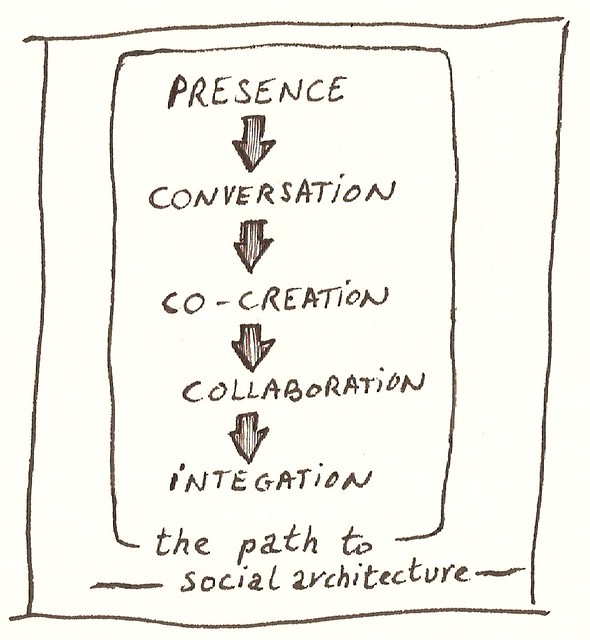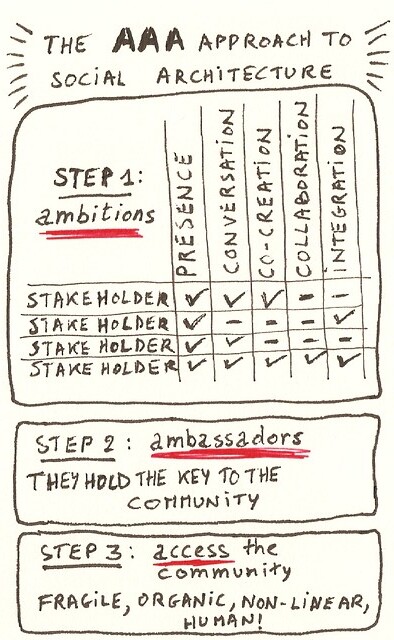In this article I am describing the five levels of social architecture that most companies are likely to bump into over the next decade. Each level has considerable challenges to overcome. That’s why I offer a AAA approach to navigate the path.
The Path to Social Architecture
If your organization finally decides it’s time to go social (after realizing that the cost of denying it has outgrown the fear of doing it), you are most likely to pass through the following stages. The model below is the path that pioneer companies are going through right now – so give and take a little by the time other organizations get there.
Level 1: Presence
- What you will be doing: you are present on different social media platforms;
- What will happen: you are receiving different signals from different channels;
- The challenge: interpretation. How on earth are you going to make sense of what’s on your dashboard?
Level 2: Conversation
- What you will be doing: you are having conversations with ease;
- What will happen: it seems like the everyone is angry at you. Conversation seems to attract disgruntled followers in the first place;
- The challenge: promises. You will be making the difference with the way you respond to unhappy followers / customers. Of course this will require making commitments, so the next challenge you are looking at is involving your team into the commitments you are making.
Level 3: Co-Creation
- What you will be doing: this is the stage where you are involving the community in the creation of your projects, be it a video, a research, a puzzle to solve,…;
- What will happen: you are experiencing unexpected creativity from an angle that you never thought of before;
- The challenge: momentum. How will you make sure that the level of engagement does not deflate?
Level 4: Collaboration
- What you will be doing: this is when you have found a way to work together with communities in the long run, i.e.: across multiple initiatives. Their engagement is high and they have a sense of belonging;
- What will happen: you will soon discover that you can’t manage it all. You will need to delegate and get out of the way;
- The challenge: organization. The big question you have at this point is ‘how do we keep it organized and goal-oriented?
Level 5: Integration
- What you will be doing: awesomeness. You are now connecting social media platforms to your back-office systems since they are more up-to-date, create less double entry and provide more accuracy (no kidding – I am not smoking pot – for example: look at the accuracy of LinkedIn versus your Applicant Tracking System – it’s a losing battle)
- What will happen: a better and more effective use of data that has always been there (you will find yourself saying ‘Duh’!);
- The challenge: systems integration and privacy. Segregation Of Duties, SOX, FDA and all other nightmares. No worries – this is the fifth level. You will have supernatural power by the time you get here.
Of course, like in a real game you can only reach a certain level when you won the challenge of the previous level. This means that you will have built a social architecture. This is the social fabric of communities on top your organization chart. It’s the lattice through which works gets done and communities are nurtured.
So on the next question you may have: ‘where to we start?’ The answer: where you stopped the last time you analysed the soft stuff of communities. Remember we used to refer to them as stakeholders? Exactly.
The AAA Approach to Social Architecture
Here’s the approach you should follow in order to get from stakeholders to communities. Unfortunately managing stakeholders has deteriorated to the level checking boxes and complying with CSR (Corporate Social Responsibility) audits. Let’s take it to the next level with our AAA approach to Social Architecture.
Step 1: map your Ambitions
For each of the stakeholders that you have identified as important for the future of your organization it is time to ask to which level you are prepared to take them. Talk about it, work it out with your colleagues, debate it at all levels, but you will need to decide on the level of engagement you are prepared to take each stakeholder. Which platform will you offer them?
Step 2: find the Ambassadors
The next question you should ask is who could be the ambassadors for these stakeholders. Ambassadors can be customers, suppliers, colleagues, neighbors, etc. who represent a larger community. Remember: communities exist already. The point is to find their ambassadors and to deserve to become their platform.
Step 3: Access the Community
This comes down to asking yourself what kind of platform you want to create: one that promotes technology, products, services, deliverables, etc? Or rather one that connects human beings? You will need to become aware of the fragile fabric that human relations are made of. At the same time you will be amazed at the results that can be achieved when trust is created.



